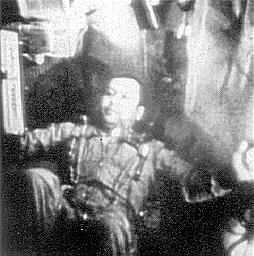
When the movie Star Wars came out in 1977, remember how many jokes were made about Luke and Han blazing away at Imperial fighters with the ack-ack guns on the Millennium Falcon?
 In the July 1998 issue of Spaceflight (the popular publication of the
British Interplanetary Society),
there's an article1
about the military version of the Soviet Salyut space station,
which flew as Salyuts 3 and 5 between 1974 and 1977. (The name
“Salyut” was applied to two entirely different space station
programs, one military and the other civilian, which used
completely different hardware built by different design
bureaux.2
The hardware flown in the Salyut 3 and 5 missions was referred
to as Almaz (Diamond) within the Soviet space program.)
In the July 1998 issue of Spaceflight (the popular publication of the
British Interplanetary Society),
there's an article1
about the military version of the Soviet Salyut space station,
which flew as Salyuts 3 and 5 between 1974 and 1977. (The name
“Salyut” was applied to two entirely different space station
programs, one military and the other civilian, which used
completely different hardware built by different design
bureaux.2
The hardware flown in the Salyut 3 and 5 missions was referred
to as Almaz (Diamond) within the Soviet space program.)
Virtually no information was available about the military Salyuts
until recently, when access was opened up to a full-scale
training model at the Moscow Aviation Institute. Well, guess
what—Salyut 3 had a machine gun. The station had a 23
mm rapid-fire cannon mounted on the outside, along the long axis
of the station “for defence against US space-based
inspectors/interceptors”. Combat engagements would have been
leisurely by Star Wars or fighter jet standards, since the only
way to aim the cannon was to point the entire station at the
target, using its attitude gyros. A periscope connected to a
visor on the main control panel allowed drawing a bead on the
intended target.
As Professor Newton pointed out some years ago, if you fire a cannon in space, you're going to end up going in the opposite direction with some haste. While permitting one to avoid a “fight or flight” decision by simultaneously exercising both options, it would be disconcerting to discover that in the heat of combat you had accidentally deorbited your battle station. So, the station was equipped with orbital maneuvering engines which automatically fired when the cannon was blazing away to cancel its recoil thrust.

|
| Pavel Popovich on board Salyut 3 during the Soyuz 14 mission, July 4–19, 1974. Televised images from the military Salyut missions are rare and of uniformly poor quality. |
According to a report in a Russian magazine,3 this lash-up was actually tested in space on an unidentified flight, but apparently under ground control at a time when no cosmonauts were on board the station. Pavel Popovich, commander of the July 1974 Soyuz 14 flight to Salyut 3, is said to have indicated that the cannon was installed on Salyut 3 but “fortunately he was not forced to use it”. A Salyut 5 crew member denies the existence of a cannon on that station, so perhaps the wisdom of outfitting a space station with a cannon was rethought, or maybe, the U.S. having had no manned spaceflight capability between 1975 and 1981, low Earth orbit was deemed insufficiently target-rich to justify such weaponry.
The Cold War may be done for, but there are still guns in space, and all of them are Russian. The survival kit in the Soyuz spacecraft which ferries cosmonauts to and from the Mir space station is said to contain, among other things, a pistol and ammunition. This is not so much to put down the occasional space mutiny, but as a precaution in case of an off-course landing in a region with dangerous wildlife. In March 1965, due to failure of the prime retro-rocket system, the crew of Voskhod 2 landed in a remote region in the Ural Mountains and rescue crews could not reach them until the next day.2,4 They were forced to retreat to their re-entry capsule to escape wolves in the forest where they landed.
Now recall that the
International
Space Station will use
docked Soyuz spacecraft as the crew's lifeboat. Imagine trying
to persuade folks back in 1986, when Ronald Reagan first
proposed “Space Station Freedom”, that when it was
finally completed in the next millennium its crew complement
would include Russians—with guns.
| Spacecraft | Launch Date | Re-entry Date | Crew / Comments |
|---|---|---|---|
| Salyut 2 | 1973 April 3 | 1973 May 28 | Failed in orbit; no crew launches. |
| Spacecraft | Launch Date | Re-entry Date | Crew / Comments |
|---|---|---|---|
| Salyut 3 | 1974 June 24 | 1975 January 24 | |
| Soyuz 14 | 1974 July 3 | 1974 July 19 | P.R. Popovich, Y.P. Artyukhin |
| Soyuz 15 | 1974 August 26 | 1974 August 28 | G.V. Sarafanov, L.S. Demin
Failed to dock |
| Spacecraft | Launch Date | Re-entry Date | Crew / Comments |
|---|---|---|---|
| Salyut 5 | 1976 June 22 | 1977 August 8 | |
| Soyuz 21 | 1976 July 6 | 1976 August 24 | B.V. Volynov, V.M. Zholobov |
| Soyuz 23 | 1976 October 14 | 1976 October 16 | V.D. Zudov, V.I. Rozdestvensky
Failed to dock |
| Soyuz 24 | 1977 February 7 | 1977 February 25 | V.V. Gorbatko, Y.N. Glazkov |